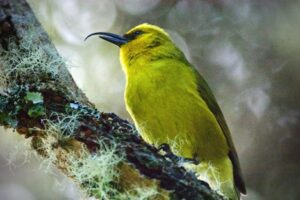BY LARRY BARNES

About 6-7 million years ago a desperate flock of Asian rosefinches lost at sea somehow found paradise – the Hawaiian Islands. They would have looked similar to our reddish house finches. The castaways found a tropical world having flowers, seeds, and insects, but no or few forest birds. The rosefinches found opportunity in a land of unoccupied niches; no finches, no woodpeckers, no parrots, no hummingbirds. And so, like a pebble dropped into a calm pool, they created ripples of new species in a process called adaptive radiation.
A milestone occurred in our own lineage around the same time. One species evolved into two, and over the next few million years those two evolved into a small bush of related primates. Evolution has pruned them back to just two species today: humans and our closest kin, chimpanzees. Our human-chimp common ancestor traveled through Central African forests at the same time that Asian landbirds were discovering Hawaii.
The rosefinches became the Hawaiian honeycreepers and in their heyday there were over 55 species. Seeing this diverse menagerie illustrated on one poster there would be little reason to conclude that they evolved from one form only 6-7 million years ago. In terms of natural selection, bird beaks are chiefly where the rubber meets the evolutionary road, and honeycreeper beaks show a staggering diversity in shape; long, thin needle-like affairs to vise-grip-crushing-style tools and everything in between. If there is a food source in Hawaiian forests suitable for birds, there is a specialized beak to get it, at least there used to be.
Meanwhile, nature worked its evolutionary magic on our own ancestry, innocently enough for several million years, creating a nice side branch of now extinct forms, arriving at our genus, Homo, about 2 million years ago. Then, just 200,000 to 300,000 years ago Homo sapiens arrived on the African scene. Like Asian rosefinches 6-7 million years ago, opportunity awaited the nascent Homo sapiens beyond the confines of Africa. And so, beginning 50,000-100,000 years ago we left Africa in fits and starts, enabled by our big brains, dexterous hands, and extremely social nature, spreading across the globe, saving Earth’s islands for last.
The trouble began in the usual way. Roughly 1,000 years ago three new mammal species simultaneously arrived on Hawaiian beaches – Polynesians, pigs, and rats. Their arrival was a trifecta of mammal-caused bird extinctions. Before this time there was just one mammal, a bat, and the islands were instead filled with a bewildering assortment of birds, many of them flightless, some of them large and meaty. The people ate the flightless birds, the pigs and rats ate their eggs. The land was transformed by fire and agriculture and rooting pigs. Many bird species blinked out. Captain James Cook began the next extinction phase in 1778.
I recently visited Hawaii to see if I might get any sense of its former glory. European boar, cats, mongooses, cattle, and many other alien species now call Hawaii home. The most dangerous among them are mosquitos and avian malaria for which native birds have little resistance. Hawaii is now a warm wasteland of alien species and a lost paradise of endemism.
But pockets of wonder persist. We visited Hakalau Forest where our government and private groups have protected and restored a cathedral of evolution. Eight of the Big Island’s nine remaining native forest birds survive here in the shade of koa and ‘ohi’a trees. Rarest and most wondrous among them is the Holy Grail honeycreeper, the one with a Swiss Army knife beak, the ‘akiapola’au. It pecks like a woodpecker with its lower mandible while probing for beetle larvae with its upper. It lays just one egg every two years, making the “aki” the least fecund member of the 6,600 species in its order (most other birds lay several eggs annually).
Our forest guide has seen seven Hawaiian bird species that are now extinct. Many other species have vanished since Captain Cook’s arrival. We can forgive the first Hawaiians for not knowing what they were doing. But we have science and reason now, and we cannot forgive ourselves.
Larry Barnes retired from 26 years as a biology teacher at Wood River High School and is now transitioning to full-time amateur exploration of the natural world.


